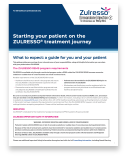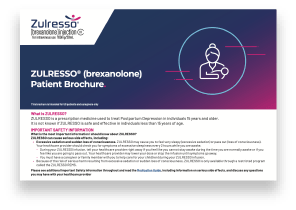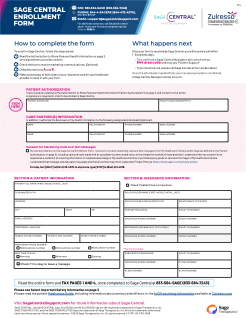You are now leaving ZulressoHCP.com
the official site for ZULRESSO® (brexanolone).
This link will take you to another Sage Therapeutics, Inc. website.
You are now leaving ZulressoHCP.com,
the official site for ZULRESSO® (brexanolone) and entering one that is not owned or controlled by Sage Therapeutics, Inc..
Sage Therapeutics, Inc. makes no representation as to the information contained on sites we do not own or control. Sage Therapeutics, Inc. does not recommend and does not endorse the content on any third-party websites. Your use of third-party websites is at your own risk and subject to the terms and conditions of use for such sites.
Resources for ZULRESSO
Supporting you and your patients with helpful resources and information.
Additional resources and information
For Healthcare Providers

For Your Patients
ZULRESSO Patient Brochure.
Looking for more information about ZULRESSO? Download the Patient Brochure

FAQs about ZULRESSO.
-
If you need help finding a Treating Center, the team at SAGE CENTRAL can help.

You can also use the locator tool to see where there is a Treating Center.
See Treating Centers -
In clinical studies, treatment with ZULRESSO was completed in 2.5 days.
-
ZULRESSO is administered into a patient’s vein by a continuous intravenous (IV) infusion. The infusion lasts 2.5 days, and treatment will take place in a REMS-certified hospital or other healthcare setting. Because of the risk of serious harm resulting from excessive sedation or sudden loss of consciousness during treatment, ZULRESSO is only available through a restricted program called the ZULRESSO REMS in which a healthcare provider will carefully monitor the patient at a certified healthcare facility.
-
ZULRESSO and some medicines may interact with each other and cause serious side effects.
Ask your patients about all the medicines they take, including prescription and over-the-counter medicines, vitamins, and herbal supplements.
Concomitant use of opioids, antidepressants, or other CNS depressants such as benzodiazepines or alcohol may increase the likelihood or severity of adverse reactions related to sedation. Ask your patients if they drink alcohol or have kidney problems.
-
Based on findings from animal studies of other drugs that enhance GABAergic inhibition, ZULRESSO may cause fetal harm.
There is a pregnancy exposure registry that monitors pregnancy outcomes in people exposed to antidepressants, including ZULRESSO, during pregnancy. Healthcare providers are encouraged to register patients by calling the National Pregnancy Registry for Antidepressants at 1-844-405-6185 or visit https://womensmentalhealth.org/clinical-and-research-programs/pregnancyregistry/antidepressants/.
-
Please see breastfeeding safety study.
-
ZULRESSO can cause serious side effects, including:
Excessive sedation and sudden loss of consciousness. ZULRESSO may cause excessive sedation or loss of consciousness during treatment. Patients should be monitored for symptoms of excessive sleepiness every 2 hours while awake.
Because of these risks, ZULRESSO is available only through a restricted program under a Risk Evaluation and Mitigation Strategy (REMS) called the ZULRESSO REMS.
Increased risk of suicidal thoughts or actions. ZULRESSO and other antidepressant medicines may increase suicidal thoughts or actions in some people 24 years of age and younger. Depression or other serious mental illnesses are the most significant causes of suicidal thoughts or actions.
The most common adverse reactions (incidence ≥5% and at least twice the rate of placebo) were sedation/somnolence, dry mouth, loss of consciousness, and flushing/hot flush.
These are not all the side effects of ZULRESSO.
-
ZULRESSO may cause dizziness and sedation, so patients should not drive or undertake any other dangerous activity until the feeling of sleepiness post-treatment has passed.
Patients should not drink alcohol while receiving ZULRESSO.
-
ZULRESSO must be administered in a REMS-certified healthcare setting so that you or another healthcare professional will be present to monitor the patient throughout treatment.
In addition, Sage Central is a source for patient support resources and programs, providing information and support to help navigate the treatment journey.
-
Sage Central provides financial assistance options to eligible patients. Once a patient is enrolled in Sage Central, they will be automatically enrolled in the financial assistance programs for which they may be eligible. Continued eligibility is subject to the satisfaction of the terms and conditions for the financial assistance programs. For more information, including terms and conditions, visit the Sage Central website.
INDICATION
ZULRESSO® is indicated for the treatment of postpartum depression (PPD) in patients 15 years and older
ZULRESSO IMPORTANT SAFETY INFORMATION
WARNING: EXCESSIVE SEDATION AND SUDDEN LOSS OF CONSCIOUSNESS
Patients treated with ZULRESSO are at risk of excessive sedation or sudden loss of consciousness during administration.
Because of the risk of serious harm, patients must be monitored for excessive sedation and sudden loss of consciousness and have continuous pulse oximetry monitoring. Patients must be accompanied during interactions with their child(ren).
Because of these risks, ZULRESSO is available only through a restricted program under a Risk Evaluation and Mitigation Strategy (REMS) called the ZULRESSO REMS.
WARNINGS AND PRECAUTIONS
Excessive Sedation and Sudden Loss of Consciousness
In clinical studies in adults, 5% of ZULRESSO-treated patients compared to 0% of placebo-treated patients experienced sedation and somnolence that required dose interruption or reduction during the infusion. Loss of consciousness or altered state of consciousness was reported in 4% of ZULRESSO-treated patients compared with 0% of placebo-treated during the infusion.
In an open-label clinical study in 20 patients ages 15 to 17 years, one patient experienced dizziness and loss of consciousness.
During the infusion, monitor patients for sedative effects every 2 hours during planned, non-sleep periods. Immediately stop the infusion if there are signs or symptoms of excessive sedation. After symptoms resolve, the infusion may be resumed at the same or lower dose as clinically appropriate. Immediately stop the infusion if pulse oximetry reveals hypoxia. After hypoxia, the infusion should not be resumed.
Concomitant use of opioids, antidepressants, or other CNS depressants such as benzodiazepines or alcohol may increase the likelihood or severity of adverse reactions related to sedation. Patients must be accompanied during interactions with their child(ren) while receiving the infusion because of the potential for excessive sedation and sudden loss of consciousness.
Patients should be cautioned against engaging in potentially hazardous activities requiring mental alertness, such as driving, after infusion until any sedative effects of ZULRESSO have dissipated.
ZULRESSO Risk Evaluation and Mitigation Strategy (REMS)
ZULRESSO is available only through a restricted program under a REMS called the ZULRESSO REMS because excessive sedation or sudden loss of consciousness can result in serious harm.
Notable requirements of the ZULRESSO REMS include:
- Healthcare facilities must enroll in the program and ensure that ZULRESSO is only administered to patients who are enrolled in the
ZULRESSO REMS - Pharmacies must be certified with the program and must only dispense ZULRESSO to healthcare facilities who are certified in the
ZULRESSO REMS - Patients must be enrolled in the ZULRESSO REMS prior to administration of ZULRESSO
- Wholesalers and distributors must be registered with the program and must only distribute to certified healthcare facilities and pharmacies
Further information, including a list of certified healthcare facilities, is available at www.zulressorems.com or call 1-844-472-4379.
Suicidal Thoughts and Behaviors
In pooled analyses of placebo-controlled trials of chronically administered antidepressant drugs (SSRIs and other antidepressant classes) that include approximately 77,000 adult patients and 4,500 pediatric patients, the incidence of suicidal thoughts and behaviors in antidepressant-treated patients age 24 years and younger was greater than in placebo-treated patients. There was considerable variation in risk of suicidal thoughts and behaviors among drugs, but there was an increased risk identified in young patients for most drugs studied. There were differences in absolute risk of suicidal thoughts and behaviors across the different indications, with the highest incidence in patients with major depressive disorder (MDD).
ZULRESSO does not directly affect monoaminergic systems. Because of this and the comparatively low number of exposures to ZULRESSO, the risk of developing suicidal thoughts and behaviors with ZULRESSO is unknown. If depression becomes worse or patients experience emergent suicidal thoughts and behaviors, consider changing the therapeutic regimen, including discontinuing ZULRESSO.
Adverse Reactions
The most common adverse reactions (incidence ≥5% and at least twice the rate of placebo) were sedation/somnolence, dry mouth, loss of consciousness, and flushing/hot flush.
Adverse reactions reported in an open-label study in patients 15 to 17 years were generally similar to those observed in clinical studies of ZULRESSO in adults with PPD.
Use in Specific Populations
- Pregnancy: Based on findings from animal studies of other drugs that enhance GABAergic inhibition, ZULRESSO may cause fetal harm
- There is a pregnancy exposure registry that monitors pregnancy outcomes in women exposed to antidepressants, including ZULRESSO, during pregnancy. Healthcare providers are encouraged to register patients by calling the National Pregnancy Registry for Antidepressants at 1-844-405-6185 or visiting online at https://womensmentalhealth.org/clinical-and-research-programs/pregnancyregistry/antidepressants/
- Lactation: Brexanolone is transferred to breastmilk in nursing mothers. There are no data on the effects of ZULRESSO on a breastfed infant. The developmental and health benefits of breastfeeding should be considered along with the mother’s clinical need for ZULRESSO and any potential adverse effects on the breastfed child from ZULRESSO or from the underlying maternal condition
- Pediatric Use: The safety and effectiveness of ZULRESSO for the treatment of PPD have been established in patients 15 to 17 years. The safety and effectiveness of ZULRESSO in patients less than 15 years of age have not been established
- Renal Impairment: No dosage adjustment is recommended in patients with mild, moderate, or severe renal impairment. Avoid use of ZULRESSO in patients with end stage renal disease (ESRD)
Controlled Substance
ZULRESSO contains brexanolone, a Schedule IV controlled substance.
To report SUSPECTED ADVERSE REACTIONS, contact Sage Therapeutics, Inc. at 1-844-4-SAGERX (1-844-472-4379) or FDA at 1-800-FDA-1088 or www.fda.gov/medwatch.
Please see accompanying full Prescribing Information including Boxed Warning.
INDICATION
ZULRESSO® is indicated for the treatment of postpartum depression in
patients 15 years and older.
IMPORTANT SAFETY INFORMATION
WARNING: EXCESSIVE SEDATION AND SUDDEN LOSS OF CONSCIOUSNESS
Patients treated with ZULRESSO are at risk of excessive sedation or sudden loss of consciousness during administration.
Because of the risk of serious harm, patients must be monitored for excessive sedation and sudden loss of consciousness and have continuous pulse oximetry monitoring. Patients must be accompanied during interactions with their child(ren).
Because of these risks, ZULRESSO is available only through a restricted program under a Risk Evaluation and Mitigation Strategy (REMS) called the ZULRESSO REMS.

